The Lenovo Ideapad Y700 Laptop Review
by Brett Howse on February 11, 2016 8:00 AM ESTGPU Performance
The Y700 is marketed as a gaming notebook, so this section may be the most important for potential buyers. The GTX 960M found inside the Lenovo Y700 is a Maxwell part, but it’s not exactly new. This is a GM107 part - so we're looking at first-generation Maxwell - and is actually the same GPU as the Maxwell version of GTX 860M (it came in two versions), but the GTX 960M has higher frequencies than its predecessor. This is definitely a mid-level card, with NVIDIA offering several cards below, and more powerful (and featured-filled) cards above this including the GTX 965M, and then the much more powerful GTX 970M and 980M.
The GTX 960M has been around since March of last year, but just due to the devices that we’ve had in for review in the last year, the GTX 960M has not graced our desks. This is a 640 CUDA core part, and it can support either two or four gigabytes of GDDR5 RAM accessed through a 128-bit bus.
As with our System tests, the Lenovo Y700 will be compared to a cross sampling of devices, but for those that want to compare it to any other system we’ve tested, please user our Notebook Bench.
First we’ll start with our synthetic tests and then move into gaming results.
3DMark
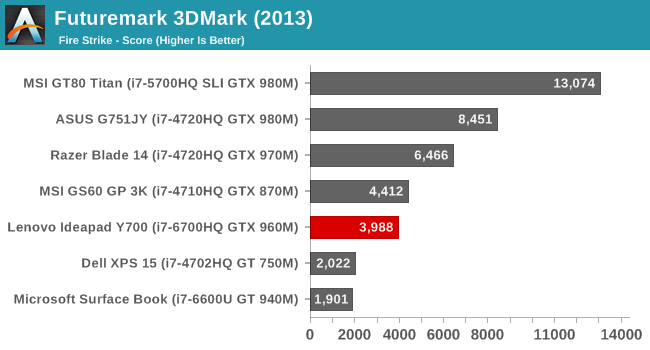
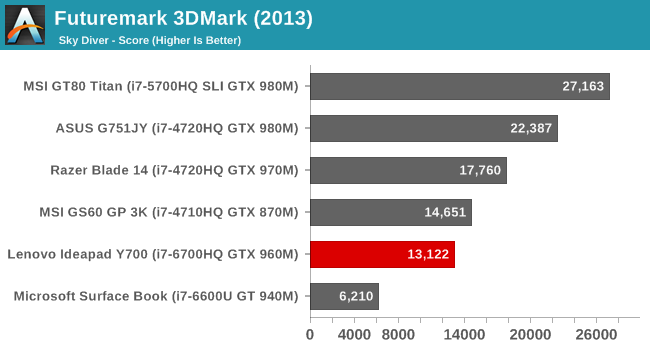
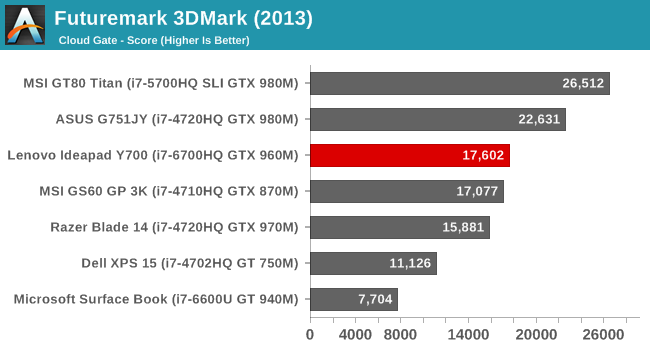
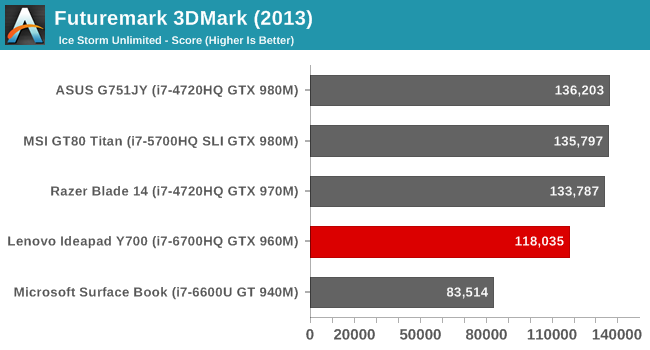
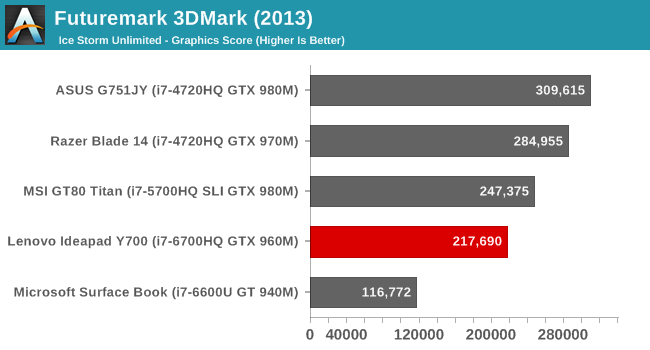
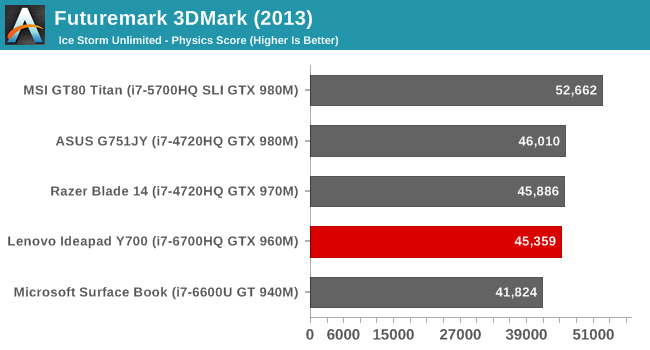

The GTX 960M paired with Core i7-6700HQ is very respectable in 3DMark, easily doubling the GT 940M performance in the Surface Book, and coming in pretty close to the GTX 870M. The bigger GPUs still offer a lot more performance.
GFXBench
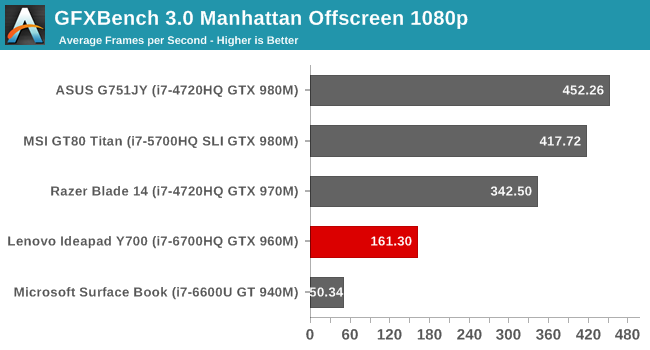
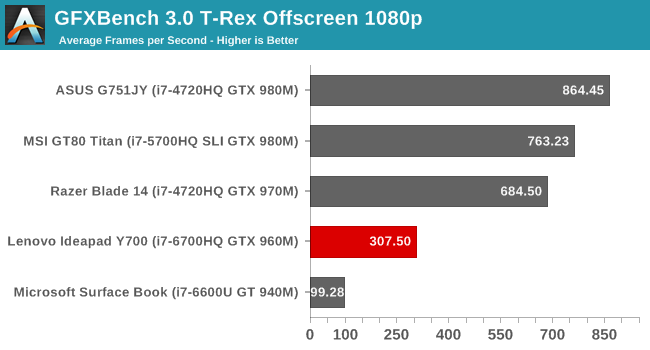
GFXBench has been updated to version 4.0 on Windows now, but it does retain a couple of the older tests. Manhattan and T-Rex are both pretty light tests by any measure of a device with a discrete GPU, and the GTX 960M aces these with no issues. There’s a big gap to the top tier NVIDIA mobile cards.
Dota 2

Valve’s Multiplayer Online Battle Arena game Dota 2 got a new engine under the hood. The new version is a lot heavier on CPU than the previous one, but it’s still a game that can be played well on low end hardware. For those that want to turn up all of the effects, the Y700 handles this game very nicely. Our enthusiast settings offered over 90 frames per second on average, and even with Dota 2 set to “Ultra” it still provides 84.7 frames per second. The Y700 would be a great entry level gaming laptop for this very popular game.
Tomb Raider
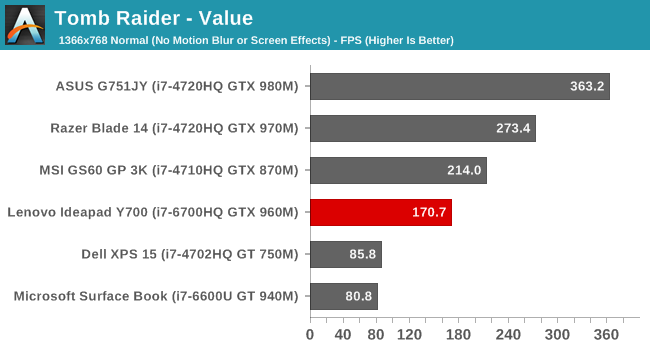
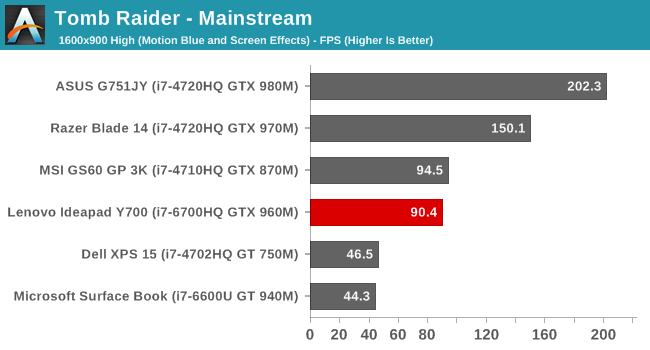
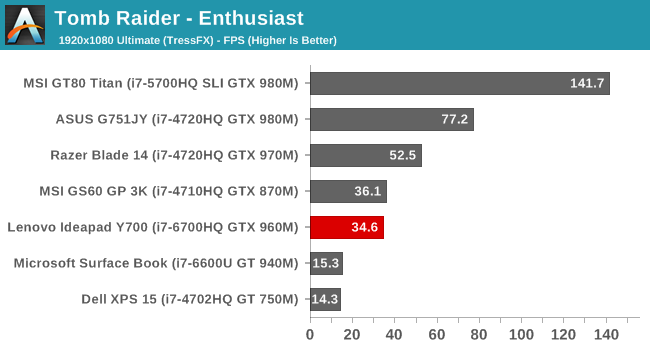
The latest version of Tomb Raider is now out, and Rise of the Tomb Raider looks to set the bar even higher than the original, but the first game in this series reboot can still be punishing with all options, including TressFX, enabled. The Y700 can handle this version pretty well, but the top settings can certainly make the system struggle. I’m hoping to add Rise of the Tomb Raider to our laptop suite going forward, but we need a couple more systems to test it on first.
Bioshock Infinite
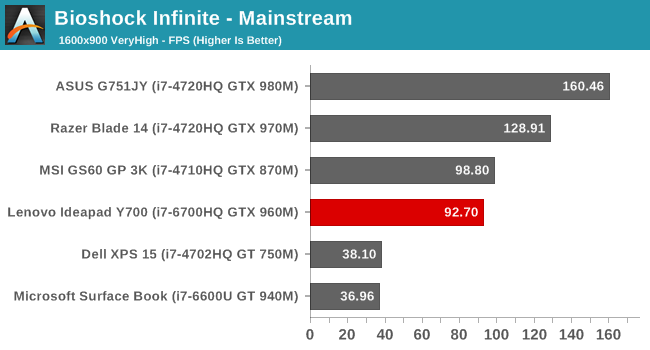

This is another game that is getting to be a bit long in the tooth, but it can still be a challenge to run on modern laptops with the settings cranked up. The Y700 is only just over 40 frames per second on Enthusiast settings, but as you can see if you turn the settings down a bit, the frame rate jumps up a lot.
Dragon Age Inquisition
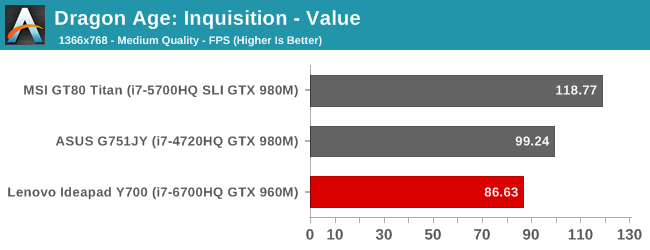


Bioware’s massive RPG can also be very punishing with settings cranked up in the game. This is the first game where the frame rate drops to unplayable on Enthusiast. Even the Mainstream settings are a struggle for this game, which has some pretty insane draw distances, and even with the 4GB GTX 960M option, it pushes this card to its limits.
Middle-Earth: Shadow of Mordor

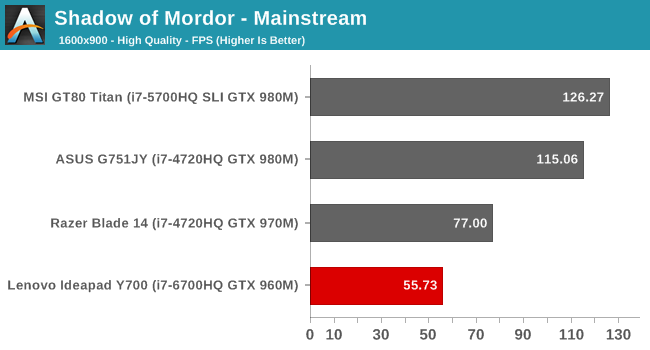
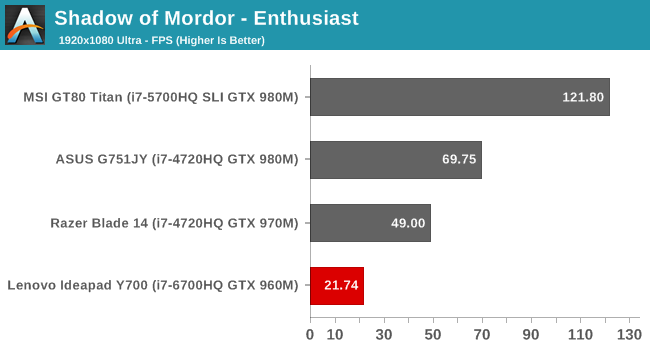
The well received action-adventure game from Warner Brothers and Monolith Productions uses the LithTech game engine, and with everything set to maximum at 1080p, the GTX 960M barely keeps an average over 30 frames per second, so once again this test is a bit too demanding for this laptop. Some tweaking of the settings with GeForce Experience would be required.
GRID Autosport
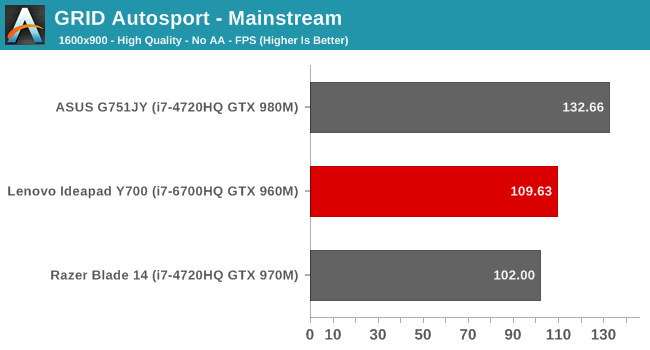

The EGO 3.0 engine which powers this latest version of the Codemasters racing series has quite a bit of dynamic range with the settings, but even on our maximum settings the frame rate average is playable. The GTX 960M is certainly at its limits already, but it still does enough to be useful, delivering over 50fps at 1080p Ultra with 4x MSAA.
GPU Conclusion
The GTX 960M is a decent graphics card for a lower cost gaming laptop. It can generally play most games at 1080p with settings dialed down perhaps a bit. If you have the UHD version of the Y700, it certainly won’t be enough power to game very well at its native resolution of 3840x2160. The base 1920x1080 model is served pretty well though with this combination.
There is still a big gap to the GTX 970M though, but we have to put the Y700 into the context of where it stands price wise. The GTX 960M is the sweet spot for performance and price.










52 Comments
View All Comments
watzupken - Thursday, February 11, 2016 - link
I am not sure if aluminium is a good material to have at the base of the laptop since its a good conductor of heat and can get quite hot at the bottom. Although its not likely anyone will put it on their lap when gaming, but still not a wise choice of material from my opinion.Also, I think it will be good to know if we can open the base of the laptop to service and to know what components can be upgraded.
willis936 - Thursday, February 11, 2016 - link
Someone better alert Apple and Dell that they're using the wrong material for the chassis of their top selling laptops.jabber - Thursday, February 11, 2016 - link
yeah as long as the heat is going into the chassis and not staying in the GPU, I'm fine with that.As intended...
ImSpartacus - Friday, February 12, 2016 - link
Yep, it's one more way to get a modest bump in cooling. That's good in my book.milkod2001 - Thursday, February 11, 2016 - link
Yeah, aluminium is bad!They should have gone with plastic instead to keep laptop cool. What they were thinking! LOLATC9001 - Thursday, February 11, 2016 - link
If a laptop has aluminum on the bottom, it would likely be cooler. This is because the heat would be dissipated quickly across the entire bottom of the laptop (huge surface area). Whereas plastic would insulate the heat and any localized hot spot would heat up at the specific point and be difficult to dissipate that heat.Samus - Thursday, February 11, 2016 - link
Exactly, plastic is an insulator, creating hot spots. Which are bad for everybody and everything involved.The only debatably superior material for the bottom chassis would be magnesium, which has similar cooling performance to aluminum while being slightly lighter and stronger...and more expensive. This is, after all, a $900 machine with a fairly high end graphics card. Sure there are laptops in this price range with magnesium construction but they also lack a $200 dedicated graphics card.
I'm surprised Lenovo used aluminum at this price. The previous Y series were mostly plastic, with questionable long term GPU reliability.
Solandri - Monday, February 15, 2016 - link
Plastic or aluminum for the bottom is mostly irrelevant. The internal components aren't connected directly to the bottom. There's a thick layer of air in between, and air is a much better insulator than, well, just about anything except vacuum. Consequently, the vast majority of cooling comes from the fans venting the interior air outside. For any heat to dissipate through the bottom case material, it has to first transfer through the air, which is an almost negligible amount.All the base needs is sufficient ventilation holes so this airflow from the fans is unimpeded. That's actually why the Macbook Pro 15 has heating problems despite using a 37W TDP CPU (the lowest power quad core Intel makes). Apple refuses to put ventilation holes in the bottom.
If you *did* attach internal components directly to the bottom, then you would want it to be plastic. Aluminum or magnesium would conduct heat so readily it'd act like a big heatsink and become too hot to actually place on your lap. Plastic would insulate your lap from the heat, thus assuring most of the heat is dissipated out via the fans.
Souka - Thursday, February 11, 2016 - link
Maybe you should read the article? Thermals were good."The results are excellent. The Y700 had no issues keeping up with the demand of the CPU and GPU, and GPU temperatures never even got over 65°C. The laptop itself was barely warm after this too, so Lenovo has packed in plenty of cooling to ensure that the system can maintain peak performance for as long as necessary."
The_AC - Friday, February 12, 2016 - link
Yeah, insulators keep computers cold. This is why I put Styrofoam blocks on my CPUs, rather than crappy copper.